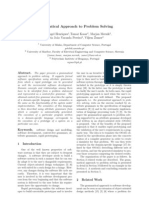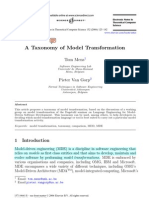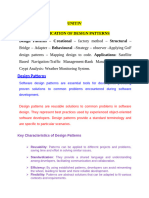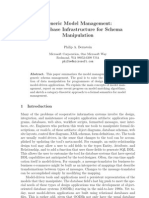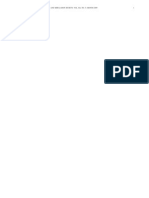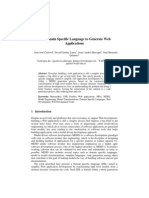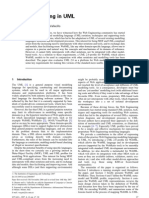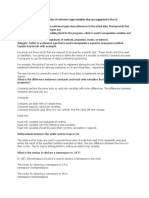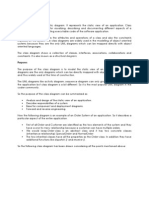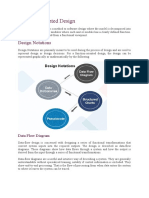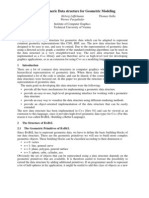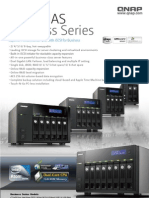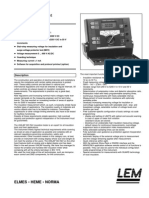Agrawal A 9-28-2004 Reusable I
Agrawal A 9-28-2004 Reusable I
Uploaded by
namnt56Copyright:
Available Formats
Agrawal A 9-28-2004 Reusable I
Agrawal A 9-28-2004 Reusable I
Uploaded by
namnt56Original Description:
Original Title
Copyright
Available Formats
Share this document
Did you find this document useful?
Is this content inappropriate?
Copyright:
Available Formats
Agrawal A 9-28-2004 Reusable I
Agrawal A 9-28-2004 Reusable I
Uploaded by
namnt56Copyright:
Available Formats
Reusable Idioms and Patterns in Graph Transformation Languages
Aditya Agrawal, Attila Vizhanyo, Zsolt Kalmar, Feng Shi, Anantha Narayanan, and Gabor Karsai
Institute for Software Integrated Systems Vanderbilt University Nashville, TN 37235, USA {Aditya.Agrawal,Zsolt.Kalmar,Feng.Shi, Anantha.Narayanan,Attila.Vizhanyo,Gabor.Karsai}@vanderbilt.edu
Abstract. Software engineering tools based on Graph Transformation techniques are becoming available, but their practical applicability is somewhat reduced by the lack of idioms and design patterns. Idioms and design patterns provide prototypical solutions for recurring design problems in software engineering, but their use can be easily extended into the graph transformation systems. In this paper we briey present a simple graph transformations language: GREAT, and show how typical design problems that arise in the context of model transformations can be solved using its constructs. These solutions are similar to software design patterns, and intend to serve as the starting point for a more complete collection.
Introduction
The practical application of Graph Rewriting and Transformations (GRT) [4] is contingent upon the existence of mathematically well-founded, yet easy-to-use tools on one hand, and on the real-world engineering experience and knowledge about the use of the techniques on the other hand. With the arrival of the ModelDriven Architecture (MDA) [3], GRT is about to become a technology that could be widely used in the industry. Although there have been a number of GRT tools developed [18, 19], few tools have been used on practical development projects, and even lesser engineering experience has been accumulated and documented about the use of these tools. We agree with the vision of MDA, where transformations on the artifacts produced during the design of software are an integral and essential part of the design process. We envision software development environments, where model transformations are used to facilitate design automation. Transformations could take place at dierent phases of the process, for instance: (1) when design models are built and some activities (e.g. applying a design pattern) are best implemented by an automated tool that transforms the models [16],(2)when components are adapted to suit the needs of a particular design context [20], (3) when designs have to be transformed into a model that can be analyzed by an
analysis tool [10], (4) when code has to be generated from the models through instantiating code fragments [21]. As these transformations must be performed on design models (which are typed multi-graphs in the most general sense), GRT techniques are applicable. There are (at least) two major motivations for using GRT in this context: (1) transformations could be complex, and a concise and precise language to program them is desirable, and (2) if the transformations are specied in a formal way (as the GRT technology allows it), we have the opportunity to reason about their properties, and how they change the properties of the models they are applied to. A language to write graph transformation programs in (and thus implement model transformations), should have a well-dened, yet simple syntax and semantics. However, there are common recurring tasks in model transformations that should not be directly supported by the language. Rather, they should be available as well-documented, reusable idioms and design patterns that solve recurring design problems. The dierence between the two is that idioms are restricted to an application domain, while design patterns are domain-independent. In this paper we describe a few such design patterns and idioms. First we describe a simple visual language that supports explicitly sequenced graph transformation and rewriting operations. Next a number of domain-independent design patterns are described, followed by a description of a non-trivial idiom. The nal sections discuss related and future work.
GReAT
The transformation language used to demonstrate the design patterns, algorithms and idioms is Graph Rewriting and Transformation language (GReAT). GReAT is a language that allows users to specify graph transformations in a graphical form with formal and executable semantics. In this paper only the necessary language constructs are explained, [7] describes the full approach and support tools. The operational semantics of GReAT is formally dened in [9]. GReAT is based on the theoretical work of graph grammars and transformations [46] and belongs to the set of practical graph transformations systems, like AGG and PROGRES. This language can be divided into four parts: 1. 2. 3. 4. 2.1 Domain specication and heterogeneous transformations Pattern specication language Graph transformation language Control ow language. Domain Specication and Heterogeneous Transformations
Many approaches have been introduced in the literature to capture graph domains. For instance, schemas are used in PROGRES while AGG uses type graphs. These are proprietary formats for the specication of the graph domain.
We chose UML [1] class diagrams and the Object Constraint Language (OCL) [2] for the specication of domains because it is standardized and it is more expressive than both schema and type graphs. The UML class diagram plays the
(a) Hierarchical dataow
(b) Flat dataow
Fig. 1. Metamodels HDF and FDF
role of a graph grammar such that it can describe all the legal object networks that can be constructed within the domain. From the UML class diagrams one can generate an object oriented API that can be used to implement the graphs, to traverse the input graph, and to construct the output graph. To satisfy the second requirement, GReAT allows the user to specify any number of domains that can be used for the transformation purposes. For example, gure 1(a) shows a UML class diagram that represents the domain of hierarchical data ow networks. A hierarchical data ow network consists of Components, DataowConnections and Ports. A component can be a either a Compound or a Primitive component, a Compound component may contain other components. Components contain port and directed dataow associations between these ports represent the ow of data. gure 1(b), represents a at (nonhierarchical) dataow language with FlatComponents and dataow connections between them. The hierarchical data ow network and at representation will serves us as an ongoing example throughout this paper. A design challenge for GReAT was to provide a uniform syntax and semantics for both graph transformations and rewriting. This problem is tackled in GReAT by allowing the user to compose source and target metamodels by dening temporary vertex and edge types that can span across multiple domains and will be used temporarily during the transformation. For example, gure 2 shows a metamodel that denes associations/edges between HDF and FDF. Component and Dataow are classes from gure 1(a) while the FlatComponent and FlatDataow are classes from gure 1(b). This metamodel denes three types of edges. There is a refersTo edge type that can exist between Component and FlatComponent, and between Dataow and FlatDataow. Another edge type associatedWith is dened and it can link Component objects. By composing the domains using temporary cross-links we are able to tie the dierent domains to-
Fig. 2. A meta-model that introduces cross-links
gether to make a larger, heterogeneous domain that encompasses all the domains and cross-references. 2.2 The Pattern Specication Language
The pattern specications found in graph grammars and transformation languages [46] were not sucient for our purposes. A more expressive, easy-to-use pattern language has been developed that allows specication of complex graph patterns. The pattern specication language was developed to extend simple patterns with a notion of cardinality on each pattern vertex and each edge. Precise semantics for such a language was developed along with ecient pattern matching algorithms. For a complete discussion on semantics, expressiveness and matching algorithms of pattern graphs please see [7]. 2.3 Graph Transformation Language
The heart of GReAT is the graph transformation language. It was inspired by many previous eorts such as [46]. It denes the basic transformation entity: a production/rule. A production contains a pattern graph, in which each pattern object: a vertex (or an edge) conforms to a type: a class (or an association) from the metamodel. Apart from this, each pattern object has another attribute that species the role it plays in the transformation. There are three roles that a pattern object can play: 1. bind : The object is used only to match objects in the graph. 2. delete : The object is used to match objects, but once the match is computed, the objects are deleted. 3. new : New objects are created after the match is computed. The execution of a rule involves matching every pattern object marked either bind or delete. If the pattern matcher is successful in nding matches for the pattern, then for each match the pattern objects marked delete are deleted and then the objects marked new are created. Pre-conditions are often required for additional constraints on the transformation application. In GReAT, OCL is used for the pre-condition specication and these constraints are evaluated on the matches before the actions are applied. There is also a need to provide values to attributes of newly created objects and/or modify attributes of existing objects. Attribute mapping is a specication of such attribute manipulation and is executed after the transformation
Fig. 3. Example rule with patterns, guards and attribute mapping
is applied. Figure 3 shows an example rule. Each object in the pattern graph refers to a class in the heterogeneous metamodel. The semantic meaning of this reference is that the pattern object should match with a graph object that is an instance of the class represented by the metamodel entity. The default action of the pattern objects is bind. The new action is denoted by a tick mark on the pattern vertex (see the vertex NewPrimitive in gure 3). Delete is represented using a cross mark (not shown in gure). The In and Out icons in the gure are used for passing graph objects between rules and will be discussed in detail in the next section. 2.4 Controlled Graph Rewriting and Transformation
GReAT has a high-level control ow language built on top of the graph transformation language with the following constructs for improving the eciency of the transformations: (1) pivoting and (2) sequencing. In this paper these issues will be briey touched upon, for a complete discussion please refer to [8]. The performance of the pattern matching can be signicantly increased if some of the pattern variables are bound to elements of the host graph before the matching algorithm is started (eectively providing a context for the search). The initial matches, called pivots, are provided to a transformation rule with the help of ports that form the input and output interface for each transformation step. Thus a transformation rule is similar to a function, which is applied to the set of bindings received through the input ports and results in a set of bindings over the output ports. For a transformation to be executed graph objects must be supplied to each port in the input interface. In gure 3 the In and Out icons are input and output ports respectively. Input ports provide the initial match to the pattern matcher while output ports are used to extract graph objects from the rule so that they can be passed along to the next rule. The rules thus operate on packets, which are dened as sets of (port, host graph object) pairs. Explicit sequencing of rules and a high-level control ow language allows the precise control of transformations and thus helps to manage the complexity
of the transformation and allows users to write ecient transformations. The control ow language supports the following features: 1. 2. 3. 4. Sequencing: rules can be sequenced to re one after another. Non-Determinism: Non-deterministic parallel execution of rules. Hierarchy: Compound rules can contain other rules. Rule reuse: The same rule can be called from dierent parts of the transformation specication. 5. Recursion: A level rule can (directly or indirectly) call itself. 6. Test/Case: A branching construct to choose between control ow paths. Sequencing is used to specify an order of execution for a set of transformation rules. For example, gure 5 shows a sequence of rules, HasComponents and Call: CollectPrimitives are executed sequentially which is in parallel with the rule IsPrimitive. Hierarchy is also shown in gure 5, where the above mentioned rules are all contained in a compound rule called the CollectPrimitives. A test/case construct is used to choose between dierent execution paths, similar to the if statement in programming languages. Figure 11, contains a test called TestProxyExistence that contains two cases (shown in gure 12). The test will rst try case HasProxy, if HasProxy succeeds then the outputs will be passed to the respective output ports and similarly for NoProxy. Once all inputs have been evaluated the next rules in the sequence will be executed.
Patterns and Idioms for Reusable Graph Transformations
Software design is commonly regarded as the most dicult stage in the software development cycle. The goal is to design a system such that it is exible, robust and reusable. Some design challenges are common and have been faced by many software designers. Over the years elegant solutions to such problems have been identied and implemented. When such a design solution is formally documented, identifying the participating elements, their roles and collaborations, and the distribution of responsibilities, a design pattern arises. A design pattern allows some aspect of system structure vary independently of other aspects, thereby promoting robustness and domain-independent reuse [13]. The same driving forces exist in the area of programming graph transformations and in the following section a few transformation patterns, algorithms and idioms will be introduced. Each pattern/idiom will be described in a uniform way with the following structure: (1) Motivation: a problem, where the need for the pattern arises. (2) Applicability: the general class of problems where the pattern is applicable. (3) Structure: the abstract specication of the pattern. (4) Benets: the advantages of applying the pattern. (5) Known uses: a set of transformations where the pattern has been known to be applied. A single motivating example will be carried throughout the design pattern discussion, and that is the attening of hierarchical dataow (HDF) to a at dataow (FDF) representation. In gure 1(a) the meta-model of the HDF has
been presented with primitives that capture dataow behavior, and compounds that are only used for encapsulating other components. The aim is to convert the tree structure of HDF to an FDF representation (see gure 1(b)) while preserving the dataow connectivity. A simple algorithm is: (1) collect all primitive nodes and copy them to FDF, (2) trace the dataow connection from each port in each primitive to a corresponding target primitive port, (3) replace this trace by a single dataow association in FDF. 3.1 The Leaf Collector Pattern
Motivation. In step 1 of the HDF attening algorithm, a requirement is to collect all leaf nodes in the hierarchy. For example, in gure 4, given the root component C we need to nd all leaf primitives P121 , P11 , P21 , P22 . Figure 5
Fig. 4. An HDF model
shows the rules that collect all the primitives in a given HDF hierarchy. The top level rule CollectPrimitives, gets as an input the root object of the hierarchy. It calls HasComponents that collects all direct children and on each child a recursive call to CollectPrimitives is made. If the input to CollectPrimitives is a primitive, then the IsPrimitive rule will succeed and will be passed to the output. At the end of the recursion, all primitives will be available at the output of the top level call. Applicability. From a starting object, traversal of a particular kind of directed association is required till leaf objects are reached. Leaf objects are dened as objects, from which the association cannot be traversed any more. Structure. The participants of this pattern are shown in gure 6. The GetDirectNeighbors rule is responsible for collecting all the direct neighbors of the input object. The IsLeaf rule is responsible for identifying if the input object is a leaf. This is achieved by a pattern with pattern cardinality equal to zero (see arrow in IsLeaf). The zero pattern cardinality on an association means that the two objects should not contain the specied association, and it is also known as the negative application condition. This implementation of IsLeaf is more general than the one seen in the dataow example.
Fig. 5. Collecting primitives in HDF
Benets. The traversal scheme and the leaf recognition are independent of each other. The processing of the leaves is separate from collecting the leaves and is typically done in a rule following the leaf collector pattern, and thus leaf collection and leaf processing can vary independently.
Fig. 6. The structure of the Leaf Collector pattern
Known Uses. (1) Collecting primitives in hierarchical structures. (2) Starting from a port nding all ports at the end of the dataow connection chain. For example, in gure 4, given port O121 , nd O21 and O221 . 3.2 The Map-Using-Link Pattern
Motivation. In attening HDF, step 1, given a set of primitives, we need to create components in FDF. In step 2, given the source and destination ports of a dataow connection in HDF, we need to nd the corresponding source and
destination ports in FDF, and make the equivalent dataow connection. In traditional programming a map would have been used to store the correspondence between HDF and FDF objects. In a graph transformation language graphs are the only data structure. Thus the maps should be encoded as graphs. In gure
(a)
(b) Fig. 7. Rules copying dataow connections
7(a) the rule CreateFlatComponent creates the corresponding FDF component for a given HDF primitive. The rule also creates a temporary association between P and FC. Creation of this association is functionally equivalent to the addition of an entry into a map. In gure 7(b) the rule CreateCorrespondingDataowConnection creates a corresponding association in FDF for a given pair of source destination ports. This is achieved by traversing the temporary associations from the parents of these ports, which is functionally equivalent to the map lookup operation. Applicability. When it is necessary to store/lookup correspondence between objects from dierent paradigms in the course of the transformation. Structure. A temporary association type needs to be dened between the two types of objects in question. Then, in the rule where the corresponding object is created/identied the temporary association is created. In subsequent rules, to lookup the corresponding object, the temporary association is used to nd the correspondence. Benets. Temporary associations that are used for representing the correspondence between objects are specied in a dierent UML class diagram. The implementation is such that the temporary associations are managed separately, leaving the source and target diagrams intact. Using graphs to represent these temporary data structures provides the exibility of implementing any data structure required, without loss of generality. Since the temporary data structures are treated in the same manner as the source and the target graphs, the transformation language remains simple.
Known Uses. In every transformation where there is more than one graph being manipulated, and correspondence between the graph objects needs to be maintained. 3.3 Transitive Closure
Motivation. In the FDF a data dependency analysis needs to be performed. For such an analysis the transitive closure [23] (see gure 8) of the dataow connection needs to be found. Figure 9 shows the transformation to compute the
Fig. 8. A directed graph G and its transitive closure G
transitive closure on FDF. The rst step of the algorithm is to nd all FDF components that do not have any incoming associations. This is achieved in FindSource using the zero cardinality association pattern. These FDF components are used as the initial value for the TransitiveClosureStep. In one TransitiveClosureStep, given a set of components, all their next and previous neighbors are found. If there is no association from the previous neighbor to the next neighbor, a new association is created between them. The TransitiveClosureStep is called again with the set of next neighbors as input. Applicability. In all situations where the transitive closure needs to be computed. Structure. The algorithm presented in gure 9 works only on directed acyclic graphs. Preprocessing steps can be used to convert an arbitrary graph into a directed acyclic graph by reducing all strongly connected components to a single vertex. In the general case the type of the association and the type of the vertex can be changed to suit the requirements of the problem. Known Uses. Used to perform reachability analysis of distributed and parallel systems and in the construction of a parsing automata. 3.4 The Proxy Generator Idiom
So far this paper has discussed design patterns that have applicability to a large set of problem domains. This section will discuss the proxy generator design idiom, which is also reusable, but is restricted to a particular problem domain.
Fig. 9. Transformation rules to nd the transitive closure
Motivation. A model for a distributed service based system (DSBS) is shown in gure 10. The distributed system (System ) is composed of multiple processors (Processor ), each processor hosts dierent objects (Object ), and objects may request service (Request ) from other objects. An object could be a proxy (Proxy ) of a remote master object (Master ) on a local processor, and such a relationship could be represented by the association Distribute between two objects. Therefore a proxy is a placeholder for another object and provides access control to it. In such distributed systems, in order to reduce network trac as well as to
Fig. 10. UML class diagram of a general distributed system
abstract network communication from object interactions, we can use proxies on each processor to represent remote components locally. This optimization can be performed by identifying the need for proxies using static analysis methods on the object network, and then automatically generating them. Figure 11 shows the transformation that identies the need for proxies and creates them. For each Master, Client pair, such that the Client needs to make requests on the remote Master, the rst step is to determine whether the Master has a proxy on the ClientProcessor. This is done in TestProxyExistence. If it succeeds in nding a proxy, then AssociateWithProxy is called, which replaces the request to the master with a request to the local proxy. Otherwise, Cre-
ateProxy is called, which creates the equivalent proxy on the clients processor, followed by a call to AssociateWithProxy.
Fig. 11. Transformation rules for the proxy generator idiom
Step 1. Determine proxy presence on local processor: This is achieved using a test called TestProxyExistence. It has two cases, HasProxy which checks the existence of a proxy for the Master in the ClientProcessor. If HasProxy is successful, the Master, Client, and Proxy are passed to the AssociateWithProxy rule. Otherwise the NoProxy case is called, that always succeeds and will pass the Master, Client pair to the next rule.
Fig. 12. TestProxyExistence
Step 2. Create the proxy (optional): In the rule CreateProxy as shown in gure 13(a), given the Master and Client, a Proxy is created on the clients local processor along with a distribute association with the Master. The newly created Proxy, its corresponding Master and the client are passed to the AssociateWithProxy rule.
Step 3. Migrate the services: In the rule AssociateWithProxy as shown in gure 13(b), given the Master and the corresponding Proxy, the clients request to the master is replaced by the clients request to the proxy. Applicability. In any distributed system where remote interactions need to be abstracted and optimized. These interactions could be service/request, event source/sink, and dataow interactions. The idiom can be used to perform a static analysis on a network of distributed objects for optimization, or can be used at runtime when the need for remote interaction arises. Structure. In the general case the idiom has three distinct parts. (1) Given a master-client pair, test for the presence of the proxy. (2) If proxy is present, remove client-master association and create client-proxy association. (3) If proxy not present, rst create a proxy and link it with the master, then remove clientmaster association and create the client-proxy association.
(a) CreateProxy rule
(b) AssociateWithProxy rule
Fig. 13. Create and associate proxy
Consequences. The pattern separates the proxy identication, proxy creation and proxy association steps such that each can be modied independently. Known Uses. Used in the Embedded System Modeling Language (ESML) [22].
Related Work
Software design patterns were documented since the early 1990s. The pioneering work was [12] where C++ idioms were introduced. However, it was [13] that contributed best of all to the acceptance and extensive use of patterns in object oriented design. In [14] generic patterns or pattern templates demonstrated extensible designs in generic languages. Graph transformation has been used to automate the application of design patterns. [16] describes an approach which uses graph queries and graph rewriting rules to apply design patterns. In particular, a PROGRES-based tool is
presented that transforms an application such that it conforms to a specic pattern. In [17] the suitability of GRS for the specication and execution of complex transformations on the static aspects of design is argued. Examples in the paper illustrate how GRS can be used to implement the design transformations proposed by MDA. [15] proposes to allow particular portions of the design to be specied in an abstract manner, with the goal of using these as patterns in order to search for corresponding implementation components. GRS is introduced as a formal method to perform the search and integration of those components. The adoption of design patterns to Graph Rewriting Systems (GRS) has just started recently. Hence little work exists in this area.
Conclusions
We have shown how the idea of design patterns applies in the context of graph transformation programs. We demonstrated the concept using three (domainindependent) design patterns and one (domain-dependent) idiom. We believe that documenting design patterns in this manner is useful for practitioners of graph transformations and we call the community to contribute to this body of knowledge. Further research in this area could lead to comprehensive compilation of design patterns and idioms that could be used to educate developers using the graph transformation technology. At this time, our tool GReAT does not have direct support for design patterns. However, we believe that templatized rules (similar to template classes in C++) could serve as the foundation for design patterns. However, the implementation of this capability is a subject for future research.
Acknowledgement
The DARPA/IXO MOBIES program (F30602-00-1-0580) and the NSF ITR: Foundations for Embedded and Hybrid Systems has supported, in part, the activities described in this paper.
References
1. J. Rumbaugh, I. Jacobson, and G. Booch, The Unied Modeling Language Reference Manual, Addison-Wesley, 1998. 2. Object Management Group, Object Constraint Language Specication, OMG Document formal/01-9-77. September 2001. 3. The Model-Driven Architecture, http://www.omg.org/mda/, OMG, Needham, MA, 2002. 4. Grzegorz Rozenberg, Handbook of Graph Grammars and Computing by Graph Transformation, World Scientic Publishing Co. Pte. Ltd., 1997. 5. Blostein D., Schrr A., Computing with Graphs and Graph Rewriting, Technical Report AIB 97-8, Fachgruppe Informatik, RWTH Aachen, Germany.
6. H. Gottler, Attributed graph grammars for graphics, H. Ehrig, M. Nagl, and G. Rosenberg, editors, Graph Grammars and their Application lo Computer Science, LNCS 153, pages 130-142, Springer-Verlag, 1982. 7. Agrawal A., Karsai G., Shi F.: Graph Transformations on Domain-Specic Models, Technical report ISIS-03-403, Vanderbilt University, November, 2003. 8. Vizhanyo A., Agrawal A., Shi F.: Towards Generation of High-performance Transformations, Generative Programming and Component Engineering, (submitted), Vancouver, Canada, October 24, 2004. 9. Karsai G., Agrawal A., Shi F., Sprinkle J.: On the Use of Graph Transformations for the Formal Specication of Model Interpreters, Journal of Universal Computer Science, Special issue on Formal Specication of CBS, 2003. 10. Agrawal A., Simon G., Karsai G.: Semantic Translation of Simulink/Stateow models to Hybrid Automata using Graph Transformations, International Workshop on Graph Transformation and Visual Modeling Techniques, Barcelona, Spain, March 27, 2004. 11. Simulink Reference, The Mathworks, Inc., Natick, MA, July 2002. T. A. Henzinger. The Theory of Hybrid Automata, In Proc. of IEEE Symposium on Logic in Computer Science (LICS96), IEEE Press, pp 278-292, 1996. 12. James O. Coplien. Advanced C++: Programming Styles and Idioms. AddisonWesley, 1992. 13. Erich Gamma, Richard Helm, Ralph Johnson, and John Vlissides: Design Patterns: Elements of Reusable Object-Oriented Software Addison-Wesley, 1995 14. Andrei Alexandrescu. Modern C++ Design: Generic Programming and Design Patterns Applied Addison-Wesley, 2001 15. Using Graph Rewrite Systems for Supporting the Software Design Process by Search for and Substitution of suitable Software Components; Sucrow, B.E., Heverhagen, T.; TAGT 98 - 6th International Workshop on Theory and Application of Graph Transformation, University of Paderborn, Paderborn, Germany, November 16-20, 1998, Research Report, tr-ri-98-201, pp. 398-406. 16. Angsgar Radermacher. Support for Design Patterns Through Graph Transformation Tools. AGTIVE 1999: pp. 111-126 17. Alexander Christoph. Graph Rewrite Systems for Software Design Transformations; Objects, Components, Architectures, Services, and Applications for a Networked World: International Conference NetObjectDays, NODe 2002, Erfurt, Germany, October 7-10, 2002. pp. 76 - 86 18. A. Schurr. PROGRES: A VHL-language based on graph grammars. In in Proc. 4th Int. Workshop on Graph-Grammars and Their Application to Computer Science, number 532 in LNCS, pages 641659. Springer-Verlag, 1991. T 19. Taentzer, G.: AGG: A Tool Enviroment for Algebraic Graph Transformation, in Proc. of Applications of Graph Transformation with Industrial Relevance, Kerkrade, The Netherlands, LNCS, Springer, 2000. 20. U.Assmann: Invasive Software Composition, Springer, 2003. 21. R. Alur, F. Ivancic, J. Kim, I. Lee and O. Sokolsky: Generating Embedded Software from Hierarchical Hybrid Models, in Proceeding of ACM SIGPLAN Languages, Compilers, and Tools for Embedded Systems (LCTES03), San Diego, California, June 11-13, 2003. 22. G. Karsai, S. Neema, B. Abbott, D. Sharp. A Modeling Language and its Supporting Tools for Avionics Systems, 21st Digital Avionics Systems Conference, August 2002. 23. Kurt Mehlhorn, Graph algorithms and NP-completeness, Springer-Verlag New York, Inc., New York, NY, USA, 1984.
You might also like
- HSBC Manu PDFDocument2 pagesHSBC Manu PDFUS BANK ONLINE TRANSFERS100% (1)
- Grammatical Approach To Problem SolvingDocument6 pagesGrammatical Approach To Problem SolvingAnirudh AgarwallaNo ratings yet
- A Taxonomy of Model Transformation: Tom MensDocument18 pagesA Taxonomy of Model Transformation: Tom MensNelson Arias HidalgoNo ratings yet
- Visual Programming and Parallel Computing: Computer Science Dept., University of TennesseeDocument10 pagesVisual Programming and Parallel Computing: Computer Science Dept., University of Tennesseerobotfreak91100% (1)
- (IJCT-V3I3P6) Authors: Markus Gerhart, Marko BogerDocument15 pages(IJCT-V3I3P6) Authors: Markus Gerhart, Marko BogerIjctJournalsNo ratings yet
- The Simple Essence of Automatic Differentiation: Conal ElliottDocument29 pagesThe Simple Essence of Automatic Differentiation: Conal ElliottfuckyoulamerNo ratings yet
- Panel Data With RDocument24 pagesPanel Data With RSantiago FucciNo ratings yet
- Lecture2 PDFDocument40 pagesLecture2 PDFmajutakgentarNo ratings yet
- Prometa: A Taxonomy For Program Metamodels in Program Reverse EngineeringDocument36 pagesPrometa: A Taxonomy For Program Metamodels in Program Reverse EngineeringDironNo ratings yet
- Bezivin Gerbe Ase01Document8 pagesBezivin Gerbe Ase01Ana PiresNo ratings yet
- Model-Driven Software Development of Model-Driven Tools: A Visually-Specified Code Generator For Simulink/StateflowDocument4 pagesModel-Driven Software Development of Model-Driven Tools: A Visually-Specified Code Generator For Simulink/StateflowhaoweiNo ratings yet
- Diseño WebDocument16 pagesDiseño WebWilder LopezNo ratings yet
- Design Patterns GoFDocument10 pagesDesign Patterns GoFtitleofyour123No ratings yet
- A Rchitecture F Ramework For Mapping Parallel Algorithms To Parallel Computing PlatformsDocument10 pagesA Rchitecture F Ramework For Mapping Parallel Algorithms To Parallel Computing PlatformsdixitmakarandpNo ratings yet
- Nina Schwarz, Daniel Kahlenberg, Dagmar Haase and Ralf Seppelt (2012) Abmland - A Tool For Agent-Based Model Development On Urban Land Use ChangeDocument6 pagesNina Schwarz, Daniel Kahlenberg, Dagmar Haase and Ralf Seppelt (2012) Abmland - A Tool For Agent-Based Model Development On Urban Land Use ChangeJuan TobarNo ratings yet
- Generic Model Management: A Database Infrastructure For Schema ManipulationDocument6 pagesGeneric Model Management: A Database Infrastructure For Schema ManipulationvthungNo ratings yet
- Pharmacy Management SystemDocument37 pagesPharmacy Management SystemSiva Kumar75% (4)
- Rugby: A Meta-Model To Study Concepts in Electronic System DesignDocument9 pagesRugby: A Meta-Model To Study Concepts in Electronic System Designhardikjoshi_25No ratings yet
- Management SystemDocument37 pagesManagement SystemJonbert AndamNo ratings yet
- Towards Domain-Specific Model Editors With Automatic Model CompletionDocument22 pagesTowards Domain-Specific Model Editors With Automatic Model CompletionSagar SenNo ratings yet
- An Overview of The OASIS TOSCA Standard: Topology and Orchestration Specification For Cloud ApplicationsDocument11 pagesAn Overview of The OASIS TOSCA Standard: Topology and Orchestration Specification For Cloud ApplicationsmostafahassanNo ratings yet
- 8-Article Ast Saoussen FinalDocument14 pages8-Article Ast Saoussen FinalNadia BouassidaNo ratings yet
- 9 Article - Caise Saoussen FinalDocument15 pages9 Article - Caise Saoussen FinalnadbouassidaNo ratings yet
- Lecture21 PDFDocument21 pagesLecture21 PDFSamuel LambrechtNo ratings yet
- A DSL To Generate WebAppsDocument14 pagesA DSL To Generate WebAppstejus111No ratings yet
- Teaching CompilersDocument5 pagesTeaching CompilersLittle_DevilNo ratings yet
- UMLtoGraphDB Mapping Conceptual Schema To Graph DatabaseDocument15 pagesUMLtoGraphDB Mapping Conceptual Schema To Graph DatabaseMaicha habibNo ratings yet
- A UML Profile For Modeling Schema MappingsDocument10 pagesA UML Profile For Modeling Schema MappingsAdviteeyaNo ratings yet
- Data & Knowledge Engineering: David Kensche, Christoph Quix, Xiang Li, Yong Li, Matthias JarkeDocument23 pagesData & Knowledge Engineering: David Kensche, Christoph Quix, Xiang Li, Yong Li, Matthias JarkeRobertMaldiniNo ratings yet
- Web MLDocument14 pagesWeb MLJoel Emerson Rojas SolizNo ratings yet
- Distributed Graphical User Interfaces To Class Diagram: Reverse Engineering Approach Using Pattern RecognitionDocument8 pagesDistributed Graphical User Interfaces To Class Diagram: Reverse Engineering Approach Using Pattern RecognitionijseaNo ratings yet
- Sengupta-Dasgupta2017 Article ArchitecturalDesignOfALMSWithLDocument26 pagesSengupta-Dasgupta2017 Article ArchitecturalDesignOfALMSWithLAwaz SaleemNo ratings yet
- Graph Grammars and Constraint Solving For Software Architecture StylesDocument4 pagesGraph Grammars and Constraint Solving For Software Architecture StylesdrewqNo ratings yet
- The Graphlet System (System Demonstration)Document8 pagesThe Graphlet System (System Demonstration)iirbas124No ratings yet
- Bauhaus - A Tool Suite For Program Analysis and Reverse EngineeringDocument12 pagesBauhaus - A Tool Suite For Program Analysis and Reverse EngineeringAyoubFathi100% (1)
- User IntDocument13 pagesUser IntzaelkzaeNo ratings yet
- Model Driven Engineering: Abstract. The Object Management Group's (OMG) Model Driven ArDocument2 pagesModel Driven Engineering: Abstract. The Object Management Group's (OMG) Model Driven Arloly5788No ratings yet
- Massing Ill 4Document29 pagesMassing Ill 4nic412No ratings yet
- Robillard 2007Document38 pagesRobillard 2007mprostakNo ratings yet
- Deployment DiagramDocument9 pagesDeployment DiagramSonia AroraNo ratings yet
- Briefly Explain The Characteristics of Reference-Type Variables That Are Supported in The C# Programming LanguageDocument7 pagesBriefly Explain The Characteristics of Reference-Type Variables That Are Supported in The C# Programming LanguagemaanicapriconNo ratings yet
- Computer Integrated Manufacturing NotesDocument31 pagesComputer Integrated Manufacturing NotesKrishna kumarNo ratings yet
- UML Class DiagramDocument4 pagesUML Class DiagramJulien Liefjerawrr CastañaresNo ratings yet
- Function Oriented DesignDocument10 pagesFunction Oriented DesignKuhoo AgrawalNo ratings yet
- Data Structures With C++Document169 pagesData Structures With C++Rachna BhatnagarNo ratings yet
- Modeling Components and Frameworks: Cris KobrynDocument8 pagesModeling Components and Frameworks: Cris KobrynOscar Luis Peña ValerioNo ratings yet
- Boundary Representation Method (B-Rep) : Boundary Representation Models Are Composed of Two PartsDocument4 pagesBoundary Representation Method (B-Rep) : Boundary Representation Models Are Composed of Two PartsAshok BhatiaNo ratings yet
- A DSL-based Approach To Product Derivation For Software Product LineDocument6 pagesA DSL-based Approach To Product Derivation For Software Product LineNesrine EglantineNo ratings yet
- Comparison of Programming Paradigms - Wikipedia The Free EncyclDocument6 pagesComparison of Programming Paradigms - Wikipedia The Free EncyclMuktesh KhobreNo ratings yet
- B B L: A Generic Data Structure For Geometric ModelingDocument7 pagesB B L: A Generic Data Structure For Geometric ModelingarcangelizenoNo ratings yet
- Two Dimensional Airfoil Optimisation Using CFD in A Grid Computing EnvironmentDocument8 pagesTwo Dimensional Airfoil Optimisation Using CFD in A Grid Computing Environmentananth9660No ratings yet
- Ajil: A Graphical Modeling Language For The Development of Microservice ArchitecturesDocument4 pagesAjil: A Graphical Modeling Language For The Development of Microservice ArchitecturesAbdu RochmanNo ratings yet
- Configurable Graph Drawing Algorithms (Jannis Pohlmann, 2011)Document124 pagesConfigurable Graph Drawing Algorithms (Jannis Pohlmann, 2011)Marco Salvatore VanadìaNo ratings yet
- 1 s2.0 S1571066106005263 MainDocument22 pages1 s2.0 S1571066106005263 MainHarri JhonNo ratings yet
- Extended Model Driven Architecture To B Method: Ammar AljerDocument9 pagesExtended Model Driven Architecture To B Method: Ammar AljerUbiquitous Computing and Communication JournalNo ratings yet
- Mahmood BrowneDocument16 pagesMahmood BrowneVerona Veez MoodleyNo ratings yet
- Tools DDDDocument8 pagesTools DDDZakaria AMdNo ratings yet
- Origami BookDocument12 pagesOrigami BookVísvësh100% (1)
- Eclipse-Based Prometheus Design ToolDocument2 pagesEclipse-Based Prometheus Design ToolfjplacidoNo ratings yet
- Article4 PDFDocument23 pagesArticle4 PDFLê KhánhNo ratings yet
- QnapDocument5 pagesQnapadokamNo ratings yet
- Server Memory Population Rules For HPE Gen11 Servers With 4th Gen Intel Xeon Scalable Processors-A50007437enwDocument21 pagesServer Memory Population Rules For HPE Gen11 Servers With 4th Gen Intel Xeon Scalable Processors-A50007437enwtehnicka.podrskaNo ratings yet
- History of C Programming LanguageDocument9 pagesHistory of C Programming LanguageRahul LavhandeNo ratings yet
- GMWIN SoftwareDocument1 pageGMWIN SoftwareĐào Đình NamNo ratings yet
- DSC 01 (BScHons) Programming Using PythonDocument3 pagesDSC 01 (BScHons) Programming Using PythonA PoddarNo ratings yet
- Error Al Autorizar Un MenuDocument4 pagesError Al Autorizar Un MenuSantiago Carrascal ArchilaNo ratings yet
- I Deleted My Facebook Account - Manas J. SaloiDocument3 pagesI Deleted My Facebook Account - Manas J. Saloipanther uploadsNo ratings yet
- Data Mining Techniques - JavatpointDocument10 pagesData Mining Techniques - JavatpointKrishnaprasad kNo ratings yet
- Lab Guide Active GridlinkDocument19 pagesLab Guide Active Gridlinktranhieu5959No ratings yet
- MCA CN Lab Manual 2019 VtuDocument22 pagesMCA CN Lab Manual 2019 VtuHemanth Aradhya0% (1)
- Unilap Iso 5 KV: The Insulation ExpertDocument2 pagesUnilap Iso 5 KV: The Insulation Expertflorin071100% (1)
- Solution For GSM Modernization 1: Huawei Technologies Co., Ltd. 1Document45 pagesSolution For GSM Modernization 1: Huawei Technologies Co., Ltd. 1lchelgeNo ratings yet
- MSP430i204x, MSP430i203x, MSP430i202x Mixed-Signal MicrocontrollersDocument79 pagesMSP430i204x, MSP430i203x, MSP430i202x Mixed-Signal MicrocontrollersscribdpinoNo ratings yet
- Download Full Event Streams in Action Real time event systems with Kafka and Kinesis 1st Edition Alexander Dean Valentin Crettaz PDF All ChaptersDocument55 pagesDownload Full Event Streams in Action Real time event systems with Kafka and Kinesis 1st Edition Alexander Dean Valentin Crettaz PDF All Chaptersvancewetta2i100% (4)
- New Trends in RoboticsDocument25 pagesNew Trends in Roboticsrettore84No ratings yet
- Compiler FileDocument50 pagesCompiler FileAgent SmithNo ratings yet
- NodeJS PDFDocument66 pagesNodeJS PDFSharvani S HNo ratings yet
- DCIT104 Lecture 1Document56 pagesDCIT104 Lecture 1Muel OpokuNo ratings yet
- It Infrastructure Management An IntroductionDocument7 pagesIt Infrastructure Management An IntroductionsghoongNo ratings yet
- Tabel SubnettingDocument1 pageTabel Subnettingiding jaenal abidinNo ratings yet
- Computer Systems Servicing 1: ST STDocument2 pagesComputer Systems Servicing 1: ST STJuren Andrew NievesNo ratings yet
- ET200SM eDocument398 pagesET200SM eRafaelNo ratings yet
- Outsurance - Complaint - Bending Over Backwards - 23Document2 pagesOutsurance - Complaint - Bending Over Backwards - 23jsinnNo ratings yet
- PAYS Instructions For New Subscribers V6Document5 pagesPAYS Instructions For New Subscribers V6Shopee PhilippinesNo ratings yet
- Script Menghapus Bloatware Sony XZ Docomo by Me2athxDocument2 pagesScript Menghapus Bloatware Sony XZ Docomo by Me2athxNajib ya'la0% (1)
- AutoCAD Color Index RGB EquivalentsDocument8 pagesAutoCAD Color Index RGB EquivalentsPanagiotis AnagnostopoulosNo ratings yet
- DAQ Toolbox ExamplesDocument52 pagesDAQ Toolbox ExamplesJosé Andrade-LucioNo ratings yet
- Gym Management Synopsis DjangoDocument18 pagesGym Management Synopsis DjangohugararakshithaNo ratings yet
- Pandas Course SlidesDocument90 pagesPandas Course Slidesjoemac007No ratings yet

